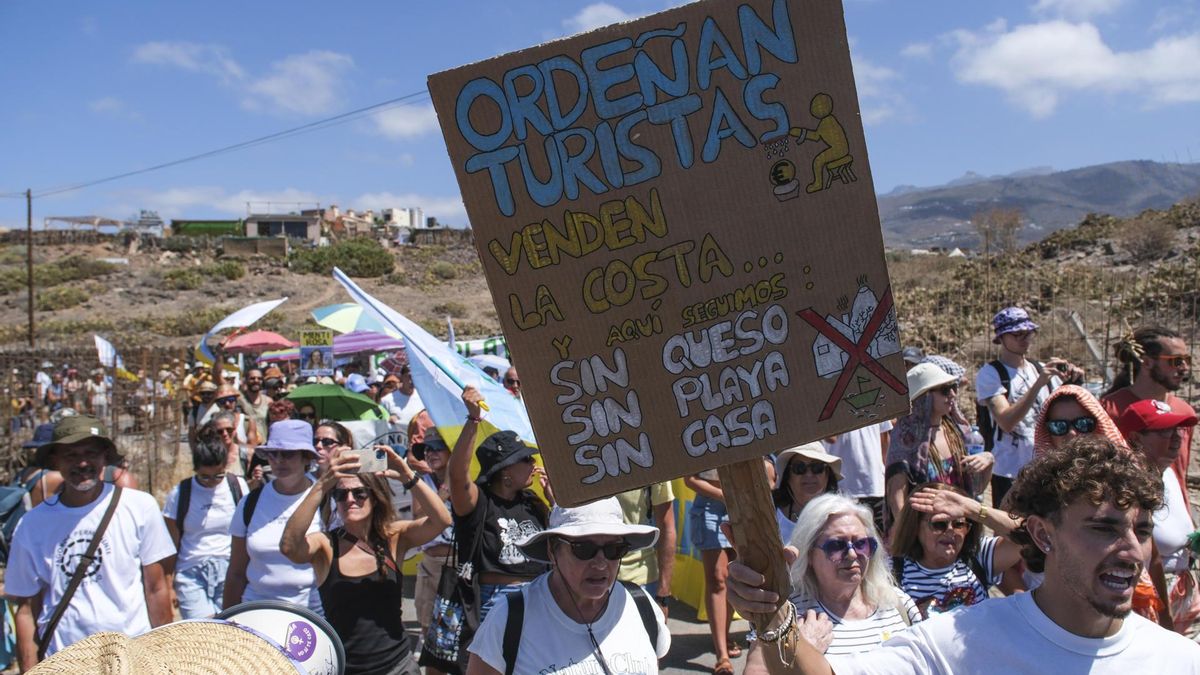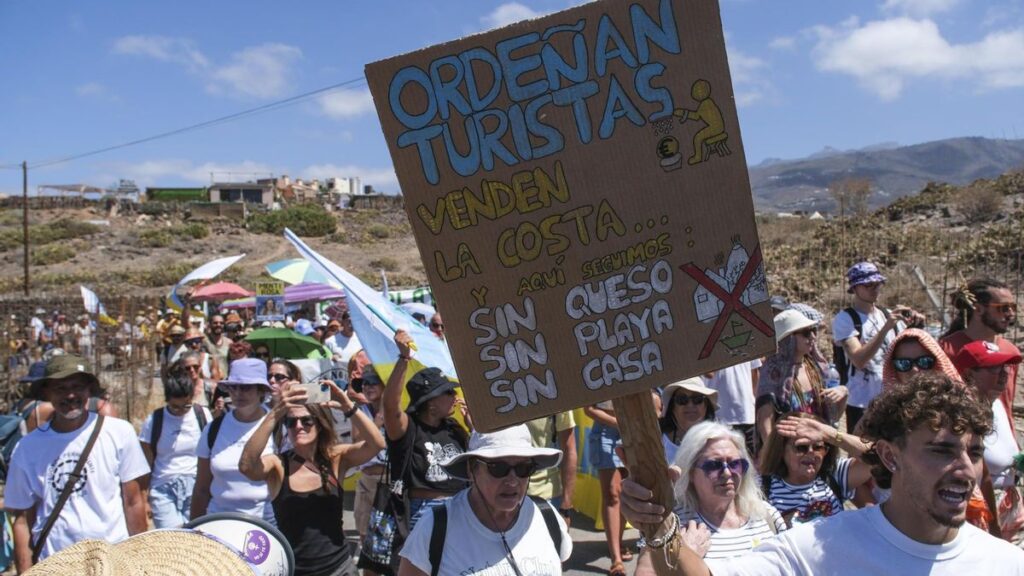A profound sense of loss
This is the question that the southern TikToker topoteopozo2 always asks in his posts. For him, as for all members of Tagoror Permanente Rotativo and countless others, something happens to us on this island. It happens to us and cuts right through us—like a Damocles sword constantly threatening our heads—a deep sensation of loss and sadness over the destruction of El Puertito de Adeje. This enclave is nestled within a vibrant landscape of incalculable value, home to more than 80 elements of historical or heritage significance, all catalogued by the relevant department of Tenerife’s own Island Council (Cabildo Insular).
More than 80, and yet this was apparently not enough to request the precautionary suspension of the misnamed Cuna del Alma urbanization project. Located in a protected Natura 2000 network zone, the project has been riddled with apparent legal breaches and irregularities from the very start.
What is solastalgia?
This profound feeling of pain for the land is, apparently, called solastalgia. The term was first coined in 2005 by Australian philosopher Glenn Albrecht. It springs from the combination of two Greco-Latin roots: solacium (consolation, peace in Latin) and álgos (pain in Ancient Greek). With this lexical marriage, the philosopher sought to describe the anxiety people experience when the landscape of their birth, upbringing, and current life is harmed.
Therefore, solastalgia—complex like any partnership—is a feeling that combines nostalgia for what was and a deep sorrow for what has been irreversibly altered. The grief for destroyed spaces transforms into a longing for connection that feels increasingly unattainable as landscapes are mercilessly changed.
A personal and collective grief
It was a few weeks ago, upon seeing a video by Lanzarote lawyer Irma Ferrer, that I decided to address this topic. On her Facebook, with a sweet Canarian accent, she speaks of this feeling of longing and sadness for the land and the fishing village whose sandy streets witnessed her first barefoot steps—a place she can no longer return to because she is overcome by a profound sense of loss caused by over-tourism. This permanent state of mourning has motivated her to investigate and pursue, through her legal work, the criminal urbanism plaguing the Canary Islands.
An ancient echo in a modern tragedy
Finding echoes of this feeling in Greek tragedy wasn’t difficult, even though ancient Greece was safe from tourist predation—unlike modern Greece, which suffers from the same drama. Tragedy served that purpose: to stir minds with beauty and grandeur, in equal measure, and transform them. Aeschylus tells us that Agamemnon, upon returning home from the Trojan War, finds betrayal and injustice; a space, his home in Mycenae, that should have been a refuge becomes a fatal trap. It was a home turned into a threat, much like our natural and cultural environment, now damaged and privatized.
In El Puertito, the three powers that in a healthy democracy should be independent have turned the environment into an object of profit and harm, ignoring environmental and heritage laws, as well as the collective will: another home that has ceased to offer protection. El Puertito de Adeje embodies a modern tragedy where an ancestral environment—like Agamemnon’s home—is destroyed by the abuse of power. In response, a contemporary Antigone has emerged in the form of an active citizenry rebelling on ethical principles.
This contemporary drama reflects not only solastalgia but also the eternal conflict between what should be safeguarded and the interests that destroy it. Between the legal and the legitimate.
The anger of a generation
I have also wondered why this feeling seems to affect young people more than older generations—if we observe the average age of the protesters. Perhaps young people feel a much deeper anguish because they have their whole lives ahead of them in a landscape devastated by speculation, which is utterly bleak. I see that this shattered landscape affects their spirits as deeply as the excavators pierce the earth that cradled them.
It’s true that people of all ages are seen at the town’s protests, but I have observed a common characteristic in all of them, besides the feeling we’re discussing: rebellion and drive, which are symptoms of youth. All of them, regardless of age, I suspect, like me, enjoyed a childhood that was happier the more their small, potter’s hands felt the early contact with mud in the first rains of those Octobers, when the afternoon sun would dry their little pots, plates, and cups or crack them to pieces.
A childhood more joyful the more they could hang an old grandmother’s quilt from four sticks next to a cardón plant, as a war shelter or an improvised nest for early loves. A childhood where with just two well-swept prickly pear leaves, joined with six little sticks, they became Homeric captains at the helm of ships capable of fording the bed of the nearest or deepest ravine, hidden from their mother’s watchful eye. Where with a small net tied to a long cane, they ventured into blue puddles by the sea, trying to find ‘pejeverdes’ fish or searching for limpets, clinging to the rocks that nourished them as tightly as the cardones do today—uprooted from the maternal slopes by hydraulic pincers.
From grief to empowered action
Precisely because of all that was lived and enjoyed, and despite the pain of this wounded identity, we have hope. That is why we fight and will do so until our last breath, until we see the traitors of our heritage, sold to the highest foreign bidder, in court for the enormous damage committed. Because well-managed solastalgia must be good for something, and for us, it will be a strong motivation driving the protection and regeneration of our environment.
When we fully recognize our pain and channel it into positive actions—such as reporting all kinds of breaches, demonstrations, concentrations, hunger strikes, camps, research, study, etc.—we become empowered. The chrysalis of our sadness metamorphoses into a butterfly that lifts its pain into tangible circuits for change. Because another Canarian reality is possible, one where the bonds with nature distill the resilience of our Guanche ancestors and strengthen their moorings for future generations.
Legends of a new resistance
They say that up there, on the heights of El Puertito, some beings have been seen gathered in a stone circle, all afflicted by the same malaise and with the same symptoms. They assure that one, with curly hair, comes down from the summit pines and, like Joan of Arc, brandishes a megaphone with the air of an ancient island heroine. That another travels kilometers from the northern midlands to be an active witness to the disaster and later account for her mourning, with the brave whiteness of her hair and her chest, in a loud voice throughout the northern towns. She is our ever-youthful Greta Thunberg.
That another comes down from the Arico midlands day after day and cries out his heroic rage in words, while praying to the Guanche deities Chaxiraxi and Acorán. And another who, with a steady voice, over the airwaves of Radio San Borondón, honors her name of a celebrated princess and represents the resistance and dignity of a people.
Yes, several beings have been seen gathered in the stone circle, their hearts wounded by the sting of progress and island speculation. We will continue to account for that diversity and the manifestations of their pain. Without a doubt, the enclave has already inspired several legends.
The mermaid of El Puertito
They say that sometimes a mermaid with light eyes, who inhabits the waters of El Puertito de Adeje, is seen coming up the rocks early in the morning, her curls waving in the landscape. They say the torment of watching a Guanche watchtower vanish under the blades—the best tabaibal scrub on the slope, the cardonal and viborina plants of the ravine, all familiar landmarks—and seeing her beloved habitat reduced to dust, with the daily roar of excavating machines since 7:30 AM, drives her to traverse every point with stifled sobs and camera in hand, to bear witness to the ongoing ecocide.
They say the brunette mermaid sometimes coils her body around a Sabandeño coral to not hear the din, though at times she must leave those waters in search of other gulps of island air. And it is rumored that on her morning journey, she often meets the ‘murión’—a young rider on a black steed of strange figure (his scooter)—who, equally stricken with grief, accompanies her on her route, asking his mobile phone camera, “What is happening here?”


